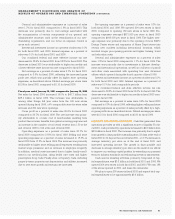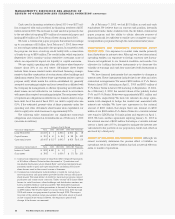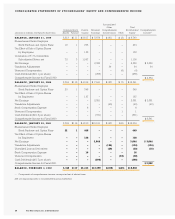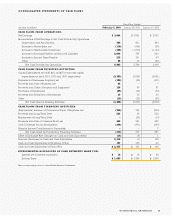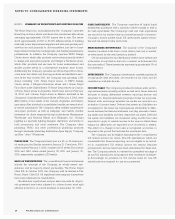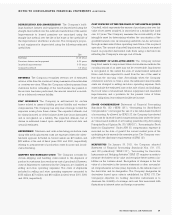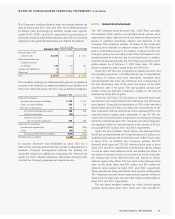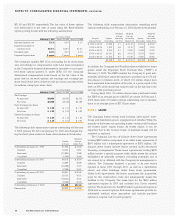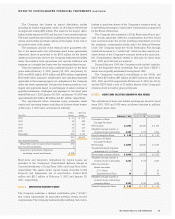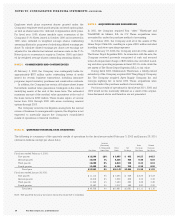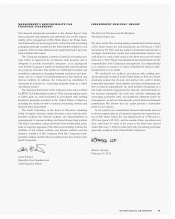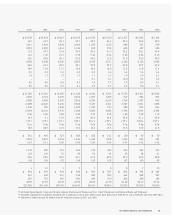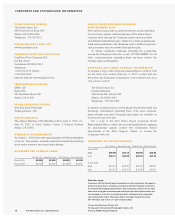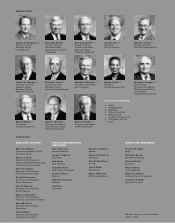Home Depot 2001 Annual Report Download - page 33
Download and view the complete annual report
Please find page 33 of the 2001 Home Depot annual report below. You can navigate through the pages in the report by either clicking on the pages listed below, or by using the keyword search tool below to find specific information within the annual report.
NOTES TO CONSOLIDATED FINANCIAL STATEMENTS (CONTINUED)
NOTE 4. EMPLOYEE STOCK PLANS
The 1997 Omnibus Stock Incentive Plan (“1997 Plan”) provides
that incentive stock options, non-qualified stock options, stock
appreciation rights, restricted stock and deferred shares may be
issued to selected associates, officers and directors of the
Company. The maximum number of shares of the Company’s
common stock available for issuance under the 1997 Plan is the
lesser of 225 million shares or the number of shares carried over
from prior plans plus one-half percent of the total number of out-
standing shares as of the first day of each fiscal year. In addition,
restricted shares issued under the 1997 Plan may not exceed 22.5
million shares. As of February 3, 2002, there were 121 million
shares available for future grants under the 1997 Plan.
Under the 1997 Plan, the Company has granted incentive and
non-qualified options for 143 million shares, net of cancellations
(of which 76 million had been exercised). Incentive stock
options typically vest at the rate of 25% per year commencing on
the first anniversary date of the grant and expire on the tenth
anniversary date of the grant. The non-qualified options have
similar terms but typically commence vesting on the second
anniversary of the date of grant.
Under the 1997 Plan, 712,000 shares of restricted stock have
been issued, net of cancellations (the restrictions on 4,600 shares
have lapsed). Generally, the restrictions on 25% of the restricted
shares lapse upon the third and sixth year anniversaries of the
date of issuance with the restrictions on the remaining 50% of the
restricted shares lapsing upon attainment of age 62. The fair
value of the restricted shares is expensed over the period during
which the restrictions lapse. The Company recorded compensa-
tion expense related to restricted stock in the amount of $3 mil-
lion and $455,000 in fiscal 2001 and 2000, respectively.
Under the Non-Qualified Stock Option and Deferred Stock
Unit Plans and Agreements, the Company issued 2.5 million non-
qualified stock options with an exercise price of $40.75 per share
in fiscal 2000. In addition, the Company granted 629,000
deferred stock units and 750,000 deferred stock units in fiscal
years 2001 and 2000, respectively, to several key officers vesting
at various dates. Each deferred stock unit entitles the officer to
one share of common stock to be received up to five years after
the vesting date of the deferred stock unit, subject to certain
deferral rights of the officer. The fair value of the deferred stock
units on the grant dates was $27 million and $31 million for
deferred units granted in fiscal 2001 and 2000, respectively.
These amounts are being amortized based upon the vesting dates.
The Company recorded stock compensation expense related to
deferred stock units in the amount of $16 million and $6 million in
fiscal 2001 and 2000, respectively.
The per share weighted average fair value of stock options
granted during fiscal years 2001, 2000 and 1999 was $20.51,
31The Home Depot, Inc. and Subsidiaries
The Company’s combined federal, state and foreign effective tax
rates for fiscal years 2001, 2000 and 1999, net of offsets generated
by federal, state and foreign tax incentive credits, were approxi-
mately 38.6%, 38.8%, and 39.0%, respectively. A reconciliation of
income tax expense at the federal statutory rate of 35% to actual tax
expense for the applicable fiscal years is as follows (in millions):
Fiscal Year Ended
February 3, 2002 January 28, 2001 January 30, 2000
Income taxes at U.S.
statutory rate $ 1,735 $ 1,476 $ 1,331
State income taxes, net
of federal income
tax benefit 172 146 145
Foreign rate differences 45 2
Other, net 29 6
Total $ 1,913 $ 1,636 $ 1,484
The tax effects of temporary differences that give rise to significant
portions of the deferred tax assets and deferred tax liabilities as of
February 3, 2002 and January 28, 2001 were as follows (in millions):
February 3, 2002 January 28, 2001
Deferred Tax Assets:
Accrued self-insurance liabilities $ 220 $ 151
Other accrued liabilities 138 118
Net loss on disposition 31 –
Total gross deferred tax assets 389 269
Valuation allowance (31) –
Deferred tax assets,
net of valuation allowance 358 269
Deferred Tax Liabilities:
Accelerated depreciation (492) (389)
Other (55) (75)
Total gross deferred tax liabilities (547) (464)
Net deferred tax liability $ (189) $ (195)
A valuation allowance was established in fiscal 2001 for a
deferred tax asset generated from the net loss on disposition of a
business. Company management believes the existing net
deductible temporary differences comprising the deferred tax
assets, net of the valuation allowance, will reverse during periods
in which the Company generates net taxable income.


